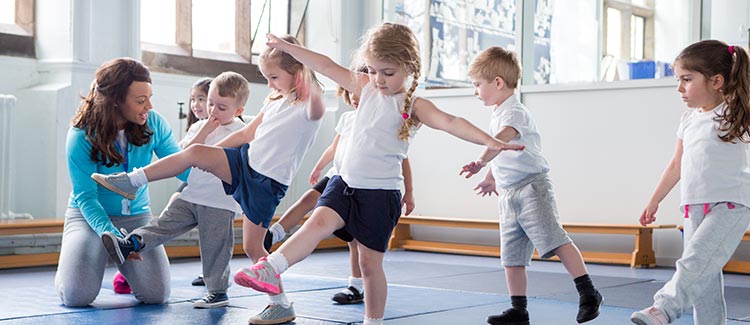Whatever you thought of gym class, the current debate over childhood obesity has made physical education (PE) more relevant than ever. As the website for First Lady Michelle Obama’s Let’s Move campaign informs us, kids need “60 minutes of active and vigorous play every day to grow up to a healthy weight.” Some schools are even using video games to lure kids to the gym. In an ideal setting, PE doesn’t just improve fitness — it also reduces stress, strengthens friendships, and improves self-confidence and self-esteem, making even kindergarten physical education worthwhile.
Is your child getting the physical education he needs? Check out our grade-by-grade guidelines to see what kids should be learning in PE.
Valuing fitness
In kindergarten, children begin to learn the value of physical activity. They should practice fitness while learning new movements and working to develop key social skills, including good sportsmanship.
Kindergartners should also learn to try new types of activities. As physical education specialist Amy Kaiser explains, “There are skills to learn and games to play. Nothing can be accomplished unless the child feels safe enough to try something new.”
Kaiser likens PE to a science lab. “Physical education is the ‘laboratory of life,’” she says. “Children [should] challenge their bodies and brains to try new tasks, accept difficult challenges, and learn a different vocabulary. When students fall down, they have to stand up again. If they drop a ball, they pick it up again. And if they lose, they learn to say, ‘That was a great game. I want to play again.’”
Movin’ and groovin’
Kindergartners should be able to try new ways of moving, whether it’s galloping, hopping, walking, running, jumping, leaping, skipping, or sliding. Kids should practice these movements while experimenting with changes in speed and direction. And teachers can play music in the background to encourage children’s creative instincts.
Classic games like jump rope can also be a great way for children to improve their balance, coordination, and aerobic capabilities. “Jumping rope is a universal game that has skills rooted in many sports,” says Kaiser. “It’s also fun and inexpensive.”
Creating balance
In kindergarten PE kids should focus on activities that incorporate the abilities to, stretch, bend, twist, turn, push, and pull. Balance is an especially valuable skill, requiring both strength and concentration, and children can improve their balance by trying creative new poses. “Children have such great imaginations,” says Kaiser, “they can create their own balance positions — a lion pose, a cobra stretch, or a crab balance. Kindergartners [love] to form their bodies into the shapes of letters.”
Balance is equally important as a building block for other exercises and relaxation techniques. “Balance [can be] a foundation for many sports and a good tool for stress-reduction activities like yoga,” Kaiser explains. “Young children who practice balance are also practicing focus and concentration, two very important skills for academic success.”
Eye on the ball
Kindergartners should learn how to throw Frisbees, small beanbags, and balls, learning the proper stance, steps, and follow-through moves. They should begin to develop their throwing, catching, and kicking skills, while practicing bouncing a ball using two hands and one hand. Kids should also practice their ball skills using their feet.
Children begin to learn to identify the parts of the body, learning how to move them during stretching and exercise. Playing games — like “Hokey Pokey” and “Simon Says” — is also great way to reinforce their new knowledge. They can use their body to show that they understand the concepts of “over,” “under,” “behind,” and “through.”
Learning social skills
Children should learn the importance of teamwork, as well. “Good sportsmanship in kindergarten is as simple and important as taking turns and recognizing others during a game,” says Kaiser. “Children at this age learn to work in pairs and small groups and can learn to appreciate others,” she adds. “It is very satisfying to hear children compliment each other when they’re trying out difficult tasks.”
Expect kids to learn how to follow the rules and procedures involved in various games and activities, including how to share and take turns. Finally, children should be taught safety. They should learn how to safely use and care for sports equipment and, more importantly, how to look out for themselves.
What to look for when you visit the classroom:
- Balls of various sizes
- Beanbags
- Frisbees
- Hula-Hoops
- Jump ropes
- Balance beam
Updated July 2010





